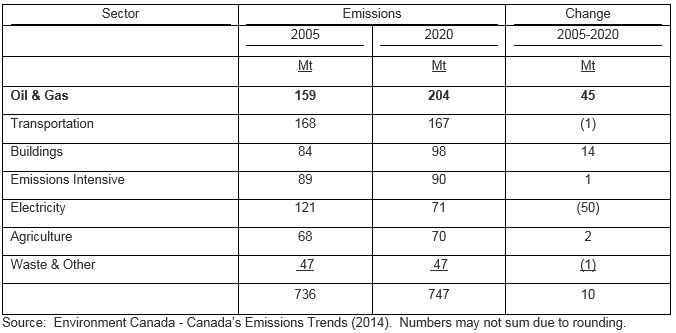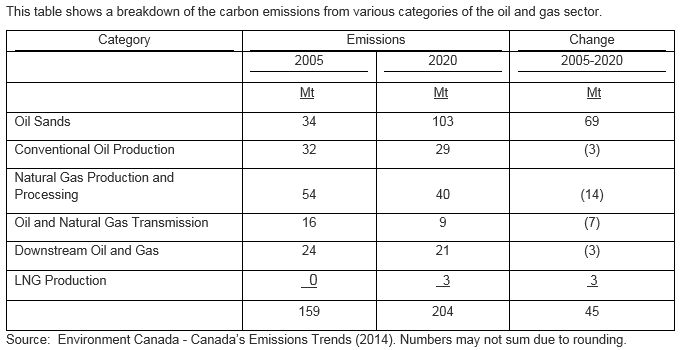As Prime Minster Trudeau and Alberta's Premier Notley prepare for the Paris Climate Change conference in the coming weeks, it cannot be lost on them that Canada's carbon emissions have either more or less levelled off or are only marginally increasing in every sector of the economy except one: oil and gas. The oil and gas sector is now the largest source of carbon emissions in Canada and emissions from oil and gas activities have been growing faster than in any other sector.
The following table sets out Environment Canada's summary of carbon emissions in Canada by sector, as at the base year (2005) and projected for the target year (2020) for measuring carbon emissions under the Copenhagen Accord.


Virtually all of the growth in carbon emissions from the oil and gas sector comes from increased activity in the oil sands. That growth effectively offsets all of the reductions made in the other parts of the oil and gas sector as well as all of the reductions made in the other sectors of the economy.
The following table breaks down the sources of carbon emissions from oil sands activities as at 2005 and projected in 2020.

According to Environment Canada's Emission Trends Report for 2013 and 2014, this increase in carbon emissions from the oil sands is tied principally to past and projected increases in production. To at least some extent, the growth in emissions as at 2020 from the oil and gas sector may be lower than projected, due to recent declines in global demand and the cancellation or deferral of a number of oil sands projects. But the overall trend is likely to remain broadly consistent with the projections from Environment Canada.
Environment Canada also suggests there may also have been some levelling off of historical trends that have traditionally led to a steady decline in the carbon intensity of the oil sands. This could be due to some technical factors, such as a gradual decrease in reservoir quality in the traditional mining facilities around Fort McMurray and increased use of natural gas to produce steam at the growing number of in situ facilities.
A few broad conclusions suggest themselves:
- In every economic sector – other than oil and gas - carbon emissions in Canada have either more or less levelled off or are declining. In some sectors - like electricity, the declines have been material.
- In the oil and gas sector, carbon emissions have either levelled off or are actually declining in almost every category other than the oil sands, as conventional oil fields are depleted or as decreases in the demand for Canadian natural gas reduces production.
- In the oil sands, growth in carbon emissions is linked principally to a growth in production itself and while there are good opportunities to decrease the carbon intensity of the oil sands, it is not immediately apparent how we can materially decrease carbon emissions while materially increasing oil sands production.
More reductions of carbon emission will be required in every economic sector if Canada is to meet its current and anticipated commitments. One of the most significant challenges in this process will be to determine how carbon emissions from the oil sands can be mitigated without impairing the viability of the oil sands generally and while continuing to enjoy their current and future economic benefits. While oil and gas producers have always been innovative, it will also take innovation on the part of our policy and law-makers to achieve an appropriate balance in the interests of all Canadians.
The content of this article is intended to provide a general guide to the subject matter. Specialist advice should be sought about your specific circumstances.

